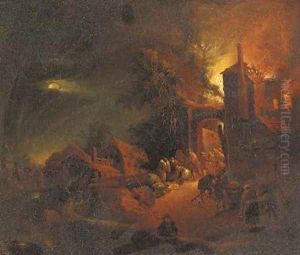Egbert Van Der Poell Paintings
Egbert van der Poel was a Dutch Golden Age painter, renowned for his captivating landscapes and genre scenes, particularly those illustrating the catastrophic events of his time. Born in 1621 in Delft, Netherlands, van der Poel's early life and training are not thoroughly documented, but it is believed that he was influenced by the works of local artists in Delft, as well as by the broader Dutch painting tradition that flourished during the 17th century. His oeuvre is characterized by a masterful use of light and shadow, a vivid portrayal of the Dutch countryside, and a remarkable ability to capture the essence of daily life as well as the chaos brought by disasters.
Van der Poel's work is most notably associated with his depictions of fires, a subject he returned to frequently throughout his career. This recurring theme is often linked to the personal tragedy of the Delft Explosion in 1654, when a gunpowder magazine exploded, devastating the city. The impact of this event on the artist is evident in several of his paintings, which not only showcase his technical skill but also convey a deep emotional response to the destruction and suffering caused by the explosion.
Despite the focus on these dramatic scenes, van der Poel's portfolio is diverse, encompassing serene landscapes, nocturnal scenes, and winter landscapes, demonstrating his versatility and keen observation of nature. His ability to depict the interplay of light, whether it be the glowing embers of a fire or the tranquil light of the moon, set him apart from his contemporaries and has contributed to his lasting legacy in the Dutch Golden Age of Painting.
Egbert van der Poel died in 1664 in Rotterdam, leaving behind a body of work that continues to be celebrated for its historical significance and artistic merit. His paintings are held in high esteem and can be found in major museums and collections worldwide, serving as a testament to his skill and the enduring appeal of his artistic vision. Van der Poel's contributions to the genre of landscape and disaster painting have cemented his place as a key figure in the canon of Dutch art, offering insight into the cultural and historical context of the 17th century Netherlands.
